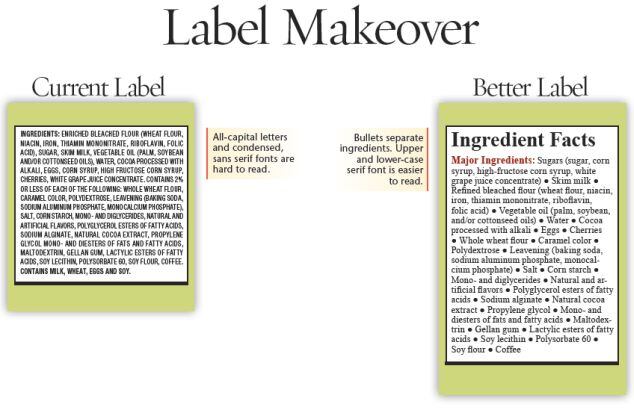The Food Labeling Modernization Act of 2013 - just unveiled by Richard Blumenthal (D-Conn) and Reps. Rosa DeLauro (D-Conn) and Frank Pallone Jr. (D-NJ) - says the FDA should establish a standard front of pack nutrition labeling system for all products, make firms label caffeine and added sugar on pack, and make ingredients labels easier to read.
It also says manufacturers should not describe as ‘natural’ products that contain artificial ingredients (including nature identical synthetic ingredients); or ingredients that have undergone “chemical changes” such as corn syrup, chemically modified starch, and cocoa processed with alkali.
However, it does not make any reference to GMOs, which are one of the biggest bones of contention when it comes to natural claims.
Attorney: This Bill has virtually no chance of passing

Rebecca Cross, an attorney at San Francisco-based law firm BraunHagey & Borden LLP, told FoodNavigator-USA that "the Bill has virtually no chance of passing".
She added: "It provides for an unnecessary and sweeping overhaul of already comprehensive (and relatively recent) regulations governing food labeling, which would only serve to confuse consumers and over-burden the FDA. The proposed definition of 'natural' appears to be reactive to some of the recent consumer class actions governing the term’s use, e.g. for high fructose corn syrup and alkalized cocoa. It does not, however, prohibit ingredients derived from genetically modified crops from being be labeled as “natural,” an issue in dozens of pending class actions, which has recently been referred to the FDA."
Ullman: I don’t have too much trouble imagining that ‘big food’ will take significant issue with this Bill
Marc Ullman, partner at law firm Ullman, Shapiro & Ullman, said “many of the aspects of this legislation seem to have a great deal of merit, most importantly the push for uniformity on front of package labels”.
However, it is unlikely to make much headway, he predicted: “I foresee the bill having a great deal of difficulty moving as there are likely to be significant differences in opinion as to the definition of ‘natural’ and the specificity required for whole grain/wheat claims.
“I don’t have too much trouble imagining that ‘big food’ will take significant issue with the latter. I’d also suggest that requiring FDA to issue guidance on the level/nature of scientific data required for structure/function claims [see detailed proposals below] falls into the ‘be careful about what you wish for’ category."
This bill is ambitious, and undoubtedly too complicated for this Congress to manage

Dr Marion Nestle, professor in the department of nutrition, food studies and public health at New York University, added: "This bill is ambitious, and undoubtedly too complicated for this Congress to manage, but it hits on many of the key reasons why the FDA is re-examining food labels in the first place.
"The items touch on precisely the areas of the food label most confusing to consumers. The labels ARE complicated so it’s not surprising that the suggestions are complicated."

GMA: Bill could have serious unintended consequences and will only serve to confuse consumers
As Ullman predicted, the Grocery Manufacturers Association (GMA) was not happy with the bill, which it said “could have serious unintended consequences on a variety of products and will only serve to confuse consumers”.
Moreover, there are already federal laws in place requiring food labels to be truthful and non-misleading, a GMA spokesman told FoodNavigator-USA: “There is a robust regulatory system in place to ensure the accuracy of information found on a food label.”
Wouldn’t it be great if parents could tell their kids, ’Buy anything you want as long as it has a green check mark’
But CSPI Executive Director Michael F. Jacobson said it was high time steps were taken to change a food labeling climate where “whole grain waffles can be made mostly of white flour, where ‘all natural’ granola bars can have factory-refined high maltose corn syrup, and where artery-clogging ice cream bars can cheerfully boast of their lack of trans fats”.
Meanwhile, a single front-of-pack labeling scheme that provided at-a-glance-information for busy shoppers trying to identify healthier foods was essential given the plethora of systems currently on the market, he said.
“Wouldn’t it be great if parents could tell their kids, 'Buy anything you want as long as it has a green check mark, or has three stars, or has a rating of 80 points or higher?”

FDA believes that a single FOP format is desirable
An FDA spokesman did not comment on the rest of the Bill but told us it agreed that a single front-of-pack nutrition labeling system was in consumers’ best interests.
“FDA believes that a single FOP format is desirable and can provide information to consumers which will hopefully help to reduce obesity and chronic disease. FDA is currently monitoring the FMI/GMA initiative, which along with other information and research (including IOM reports) is informing our thinking about this issue going forward.
“A precise timeframe for developing any front-of-package labeling system has not been set at this time."
Andy Bellatti: I absolutely agree that added sugars need to be on the Nutrition Facts label
So what do dietitians think?
Registered Dietitian (RD) Andy Bellatti said he welcomed many of the proposals, although he would still advise consumers to ignore most front-of-pack claims and look at the ingredients list instead.

He added: "The term 'natural' has been so overused and misused that I think it's lost all meaning. Rather than attempt to define it, I'd prefer people always read an ingredient list. I also think any product that contains GMOs should not be labeled 'natural'.”
As for added sugars, he said: “I absolutely agree that added sugars need to be pointed out on the Nutrition Facts label. This will especially make people realize just how much added sugar is hiding in yogurts and flavored milks."
He also welcomed the proposal to group sweeteners together on the ingredients list: "I completely support bunching together all sweeteners into one general category on an ingredient list. Separating eight different sweeteners on an ingredient list gives the illusion that added sugars are not the first ingredient - when they often are."
The proposal to list the percentage of grains in a food that are whole grains is a good idea, he said, but added: “I don't like the notion that as long as a food has more than 50% of its grains in whole form it can be labeled ‘healthy’. 100% whole-grain products can still contain high amounts of added sugars, or partially hydrogenated oils."
Whole Grains Council: We support a change in the law requiring packages to say 'x% of the grain is whole grain'
Cynthia Harriman, director of food and nutrition strategies at the Whole Grains Council and Oldways, said she supported including whole grains in the FDA definition of ‘healthy’ and labeling the percentage of the grain that is whole grain.

FDA currently requires that percentage declarations be computed as a percent of total weight of all ingredients, which is unhelpful for a product like bread, which contains a lot of (heavy) water, she said: “Although FDA makes an exception for the term ‘100% whole grain’ as meaning 100% of the GRAIN is whole grain, if you were to say ‘75% whole grain’ it would have to mean 75% of the weight of ALL INGREDIENTS are whole grain.”
For example, if 80% of the grains in your bread are whole grains, but they represent only 44% of the weight of the bread, the permitted label - '44% whole grain’ - is pretty confusing, she said, as it wrongly implies that 56% of the grain is refined.
“A change in the law requiring packages to say "x% of the grain is whole grain" would solve this problem and we would support this change.”
We have summarized the proposals in HR 3147 below, but for a full description, download the Bill in full (PDF) here.
1 - FRONT OF PACK LABELS - FDA should establish a standard front of pack nutrient labeling system for all products that reflects the findings of the 2011 IOM report.
2 - WHOLE GRAINS/WHEAT - Foods featuring labels such as ‘made with whole grain’ or ‘multigrain’ must express the amount of whole grains in a food as a percentage of the total grains in the product (eg. 27% of the grains in this loaf are whole grains). Products using the terms ‘wheat’ or ‘whole wheat’ on the front of pack must disclose the percentage of whole wheat by weight contained in the product next to these terms.
3 - NATURAL CLAIMS - Products may not use the term ‘natural’ on a label if they contain artificial ingredients including flavors and colors; synthetic ingredients that are ‘nature identical’; or any ingredient that has undergone “chemical changes”. Examples given are corn syrup, chemically modified starch, and cocoa processed with alkali.
However, foods containing ingredients that are smoked, roasted, frozen, or fermented, or have undergone “traditional physical processes” such as separating eggs into albumen and yolk or pressing fruits to produce juice, may be described as ‘natural’.
4 - HEALTHY CLAIMS - Foods containing grains should not be labeled ‘healthy’ unless at least half of the grains are whole grains.
5 - CALORIES - Foods should list the calories per serving of a product and give the percent daily value for calories provided by that serving.
6 - ADDED SUGARS - Added sugars should be included on the nutrition facts panel, with a %DV.
7 - CAFFEINE - Labels should disclose caffeine levels per serving for products containing more than 10mg caffeine per serving.
8 - COLORS, SWEETENERS - If foods contain artificial colors, natural colors, added artificial sweeteners (eg. aspartame) or natural non-caloric sweeteners (eg. stevia), this must be highlighted on the front of pack.
9 - STRUCTURE/FUNCTION CLAIMS - The FDA should issue guidance on the scientific data needed to support structure/function claims and have the legal authority to compel companies making such claims to turn over their data.
10 - TRANS FATS - Trans fat levels must be disclosed if low cholesterol claims are made, and low trans fat claims should not be made if a product contains cholesterol. Similarly, if a product with a low trans fat claim also contains more than 1g of saturated fat, the amount of sat fat should be disclosed next to the low trans fat claim.
11- LABELS FOR SINGLE-SERVE PACKAGING - Requires any product containing in its package an amount of food reasonably consumed in a single occasion to state on the label that a single package contains one serving size.
12 - CLEARER INGREDIENTS LABELS - Format should be clear, with bullet points, different text, more contrast etc. Sugar, non-caloric sweeteners, and sugar alcohols should be considered separate groups and listed parenthetically within each group in their order of predominance within that group.

